After learning that none of the RCMP officers who shot her son will be charged, the mother of Jared Lowndes is calling for an inquiry into why police have killed so many Indigenous people in Canada.
“This is not over, I’m not going to stop. I will continue to fight for justice for Jared, I will continue to fight for justice for all Indigenous people who have been killed,” Laura Holland told reporters Tuesday following a meeting with Crown prosecutors in downtown Vancouver.
“I will continue, and if it means we need an inquiry into why they’re doing this... to change some of the policies and procedures that [the BC Prosecution Service is] bound by, if we need to continue to address systemic racism, we will do that.”
Lowndes died on July 8, 2021, in Campbell River after he was pursued by RCMP officers who attempted to subdue him with a police dog, a Taser and gunshots and by smashing into his car with a police vehicle. He was 38.
B.C.’s police watchdog, the Independent Investigations Office, investigated and had determined that “reasonable grounds exist to believe that three officers may have committed offences in relation to various uses of force.”
Holland and her son are from the Laksilyu Clan of the Wet’suwet’en Nation.
The IIO submitted a charge report to Crown prosecutors. But on Tuesday, the BC Prosecution Service announced that after reviewing the events that led to Lowndes’s death, prosecutors were not able to prove beyond a reasonable doubt that officers had committed any offence.
Holland said she was insulted that staff with the BC Prosecution Service offered to connect her with victim support workers during the meeting where they explained that the officers who shot her son would not be charged.
“Do I look like a victim? Can victim support workers give me access to the same money and lawyers that the police have? No,” she said. “It has been 1,020 days that I have waited to hear what proposed charges might be — and there are none.”
Neil Chantler, a lawyer who has been supporting Holland, said the BC Prosecution Service’s decision is disappointing and not what he expected.
“People are very disappointed that this case isn’t going to see the light and exposure of a trial. If not this case, it’s hard to imagine a case meeting the charge approval standard,” he told reporters.
“This was a case that we all thought clearly met that standard from the outside and should have gone to a trial — this is one of those cases where we would have liked to see justice be done in the open.”
The decision comes after the BC Prosecution Service announced it would stay proceedings in another high-profile case.
On April 5, the prosecution service announced it would stay proceedings against two RCMP officers, Const. Paul Ste-Marie and Const. Jean Francois Monette, charged with manslaughter in the 2017 death of Wet’suwet’en and Gitxsan man Dale Culver. Culver died after being pepper-sprayed and kicked in the head while being taken into custody in downtown Prince George.
While an original autopsy determined that police actions contributed to his death, leading to charges being laid on Feb. 1, 2023, a review of the pathology results disagreed with the original findings. As a result, it was determined there was “no longer a reasonable prospect of conviction” in the case.
What happened on July 8, 2021
The BC Prosecution Service published a lengthy statement that laid out the facts as prosecutors understand them.
Lowndes’s interaction with RCMP officers started early in the morning on July 8, 2021, when an officer looked up Lowndes’s licence plate and saw there was a warrant out for his arrest for “allegedly breaching a conditional sentence order for a firearms offence.”
BCPS explains that a conditional sentence is “a jail sentence that an offender is permitted to serve in the community” instead of a prison.
The officer approached Lowndes’s car, but he reversed and drove away, striking the police officer’s car. RCMP officers were then on the hunt for the car, which another officer saw north of Campbell River. Another officer with a police service dog was called to assist, while more RCMP officers joined the search for Lowndes.

As Lowndes approached a drive-thru window at a restaurant in Campbell River, RCMP officers tried to box his car in with their vehicles, but he was able to reverse out of the drive-thru lane and drive through the parking lot, with police cars in pursuit. He struck some of the other cars in the parking lot as he tried to get away from police, but officers finally succeeded in blocking his car with their vehicles.
According to the BCPS’s statement, officers approached Lowndes’s car with their guns drawn and commanded him to show his hands. According to the statement and dashcam video reviewed by investigators, Lowndes sprayed bear spray at the officers. The police dog handler then lifted the police dog into Lowndes’s car, leading Lowndes to stab the dog with a knife. According to the statement, Lowndes also cut the officer’s hand as he tried to fend off the dog with the knife.
Police then shot Lowndes with a Taser, but it had “no effect.” Lowndes then opened the door of his car, pushed out the wounded police dog and exited the car, still holding the knife, according to the statement.
Two officers then shot Lowndes in the back, according to the BCPS statement. At the same time, another officer drove his police car into Lowndes’s car, “likely running over Mr. Lowndes who at this point was on the ground.”
While the statement does not mention anything about Lowndes having his own dog in the car, his family has previously said they believe he may have been trying to protect his own dog when he stabbed the police dog.
Why the prosecution service declined to charge the police
Prosecutors considered charges of manslaughter, discharging a firearm and aggravated assault. But the BC Prosecution Service doesn’t proceed with charges without having a “substantial likelihood of conviction” and a decision that prosecution is in the public interest.
Prosecutors believe that during a trial, lawyers for the police officers involved would have likely been able to mount a successful defence to any of those charges by arguing that Lowndes’s behaviour put the police officers and public at risk.
Specifically, Lowndes’s use of bear spray “was a significant escalation of violence” and the way he drove out of the parking lot, hitting other parked cars, “created a significant risk to members of the public.”
Crown prosecutors said they would be unable to prove that it was unreasonable for the officers to have concluded that Lowndes was a threat to the public as long as he was in his car, so “it was not unreasonable to proceed with some urgency to remove him from the vehicle and effect the arrest.”
Chantler said Lowndes’s family expected to see those questions answered in court during a trial.
“Essentially, the Crown has determined that there is no substantial likelihood that a trier of fact could find it unreasonable, unnecessary or excessive to: a) use police vehicles to ram and box in Mr. Lowndes’s vehicle at the parking lot; b) to physically insert a police dog into a stationary vehicle with one occupant and his dog; c) to Taser an individual seated in his vehicle; and d) to fatally shoot an individual immediately upon exiting his vehicle,” Chantler told The Tyee.
“It seems quite possible a court could have found the police officers’ use of force to be unreasonable, unnecessary and excessive in these circumstances.”
Chantler said police are not trained to use a police dog as the RCMP officers did in Campbell River.
“It begs the question: ‘What were they trying to accomplish by putting Mr. Lowndes in this situation?’” Chantler said.
“It appears the police created the violent and chaotic circumstances that lead to Mr. Lowndes’s death.”
With files from Amanda Follett Hosgood. ![]()
Read more: Indigenous, Rights + Justice

















Tyee Commenting Guidelines
Comments that violate guidelines risk being deleted, and violations may result in a temporary or permanent user ban. Maintain the spirit of good conversation to stay in the discussion and be patient with moderators. Comments are reviewed regularly but not in real time.
Do:
Do not: